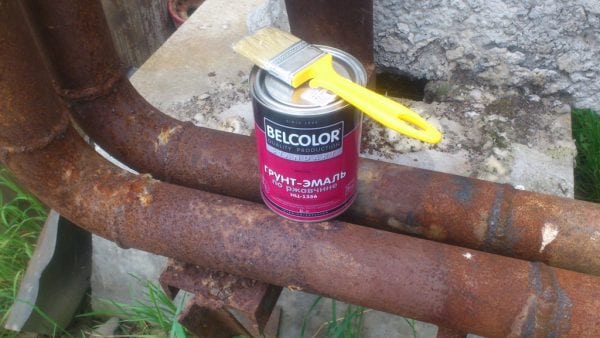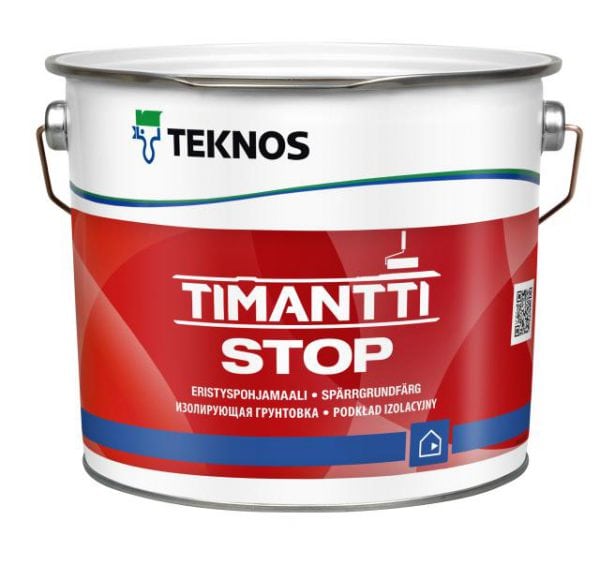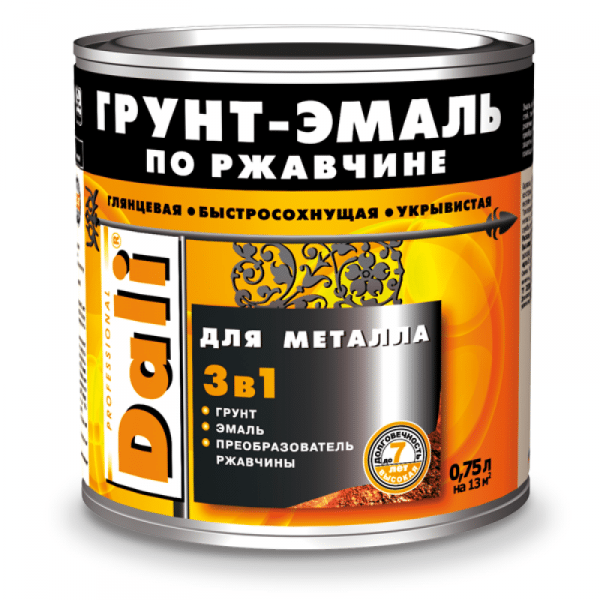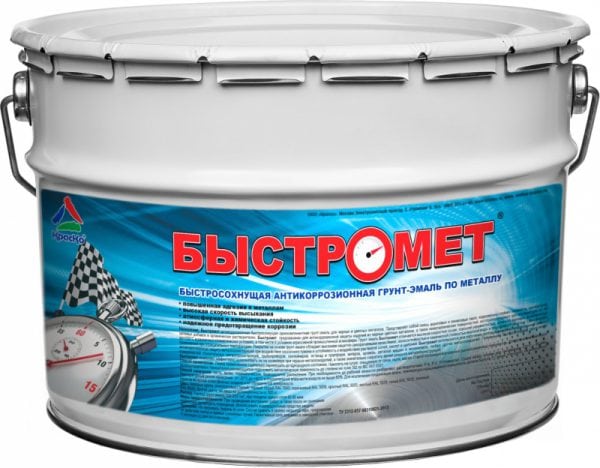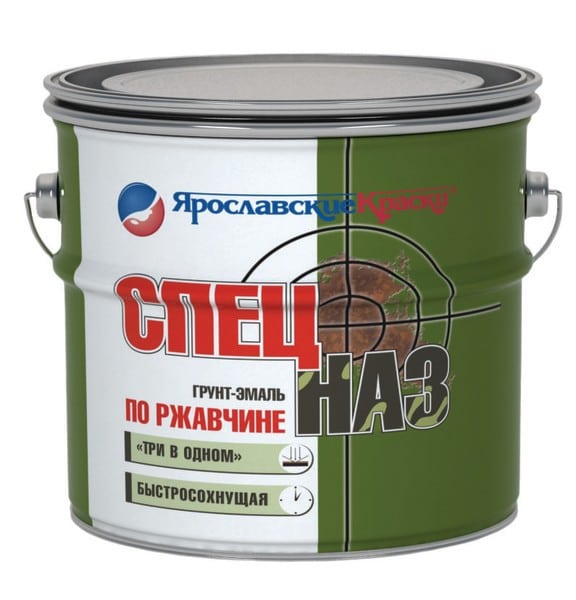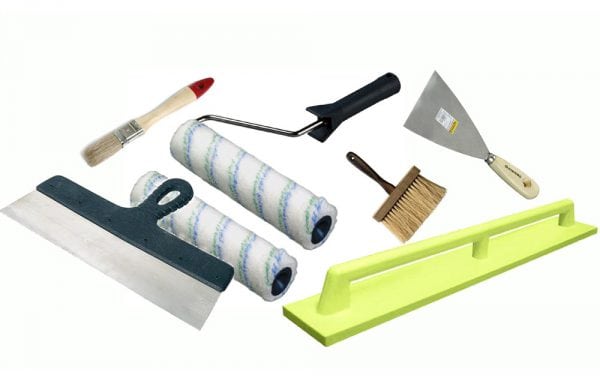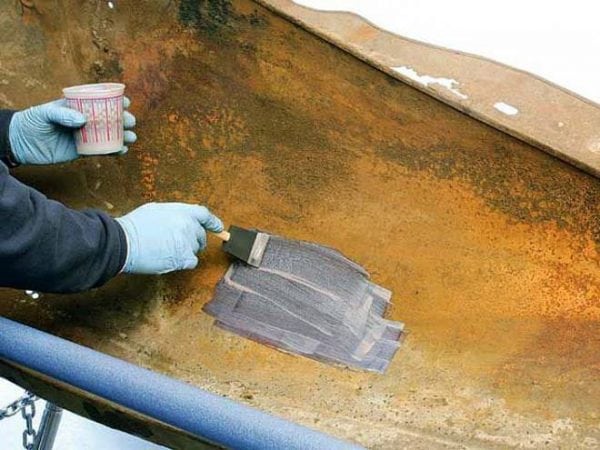Such a phenomenon as the oxidation of a metal and its gradual destruction under the influence of moisture, is known as corrosion. But how to deal with it? If the rusted area is large, then it can be restored only with the help of complex work, but small areas can be really protected by applying enamel on rust.
- Varieties of corrosion protection
- Insulating
- Passivating
- Converter
- Phosphating, two-component
- Tread
- Inhibitory
- Material Examples
- How to choose a dye
- How to choose a tool
- How to paint
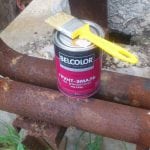
Varieties of corrosion protection
To treat small areas or to prevent the occurrence of corrosion, rust enamel is used. Such paint combines three properties: enamel, primer and rust converter. But anticorrosion paints are just a generic name for drugs that vary in composition. Depending on the anti-corrosion components that make up their composition, they are divided into the following groups.
to contents ↑Insulating
Such a primer-enamel on metal after drying forms a durable film that blocks access to the base of water and oxygen. These dyes, as a rule, are made on the basis of minium and additionally have heat-resistant qualities.
These characteristics allow them to be used for street work and for painting surfaces in water. Quick-drying: after 2-3 hours, this coating provides reliable corrosion protection.
to contents ↑Passivating
Such primer paint is used to slow down the development of corrosion. Its anticorrosive substances, by their chemical formula, significantly slow down the course of oxidative processes. Suitable for use in places of high humidity.
Converter
It contains orthophosphoric acid. Acid after a chemical reaction with iron oxide (corrosion) forms a strong and inert to oxidative processes iron phosphate. The use of converters allows not only to protect the structure from destruction, but also partially restore the damaged metal base.
to contents ↑Phosphating, two-component
The composition includes phosphoric acid and passivating additives. It has a low consumption when applied to the surface, has high adhesion. Coating with such paints is possible even for galvanized metals, which it is practically impossible to process with other anti-corrosion agents.
Tread
Corrosion-resistant enamel with the smallest metal particles dissolved in it after drying forms a strong metallized coating. The use of paints with protectors is recommended in conditions of high humidity.
Quick-drying primer-paint not only has high anti-corrosion properties, but also is economical: its consumption per 1 sq. M is small.
to contents ↑Treads are often used to paint boats or metal piers in water.
Inhibitory
It has a unique formula. Such rust-based primer-enamel gives the oxidized structure after interaction with it the properties of a primer. Inhibiting paints are quick-drying and have high adhesive qualities.
Their disadvantages include a large, compared with other primer paints, material consumption caused by abundant impregnation of the rust structure. But, despite this small drawback, inhibitory paints are most in demand to provide corrosion protection and decorative staining of metal products.
A dye selected in accordance with the technical characteristics will stop corrosion only if:
- The plot of rust is small.
- Rust has a firm grip on the metal base.
The use of paint three in one with large damage to the product or on a loose, fragile area of rusting does not give a positive anticorrosive effect. For such violations of the metal structure, capital restoration work is required.
to contents ↑Material Examples
Among the existing colors stand out "Dali" from the company "Rogneda", as well as the enamel primer "Stop Rust". The consumption of Stop Rust material is between 80 and 150 g per square meter. One liter of Dali paint, according to the technical specifications, is enough to cover 12 square meters.
How to choose a dye
Rust enamel, combining the properties of a decorative coating, primer and rust protection (three in one), is recommended to be selected taking into account the following parameters:
- Type of metal. Depending on the type of alloys, the type of corrosion protection is selected, as well as the type of base (water or oil).
- Effects on the product (humidity, temperature changes, the probability of mechanical damage).
- The degree of protection of the dye, what kind of coating it forms on the surface (a kind of film for protection).
- The nature of corrosion (develops quickly or not, the size of the damaged area, etc.).
- Drying speed. For outdoor use or when painting surfaces in contact with water, quick-drying paints must be used.
- Toxicity. Most anti-corrosion dyes that provide a strong protective coating are highly toxic, therefore it is recommended to work with them in a well-ventilated area using gloves and a respirator. The degree of toxicity can be found by studying the composition indicated on the package.
- Profitability. In most cases, anti-corrosion agents have a low consumption per 1 sq.m. A relatively high consumption can be associated either with increased protective properties of the product, or with the friability of a rusted surface.
- Decoration. Unfortunately, all paints that help prevent or eliminate minor corrosion damage, due to the nature of the composition, are only available in black, gray or brown. But when purchasing a coloring agent, you should pay attention to the gloss: matte or glossy.
How to choose a tool
Most three-in-one paints contain aggressive chemicals that corrode artificial fabrics. For applying a coloring substance to a metal base, the following painting tools are used:
- Brush. Due to the aggressive substances that make up most primer paints, brushes need to be chosen with a natural pile. For uniform distribution of the drug without sagging, the masters recommend acquiring thick wide brushes.
- Roller. It is better to choose a “fur coat” for a roller from velor or polyacryl with medium or short pile. Before purchasing, the roller should be studied to find out for which coloring matter it can be used.
- Airbrush.Only models without plastic parts are suitable (plastic deforms under the influence of anticorrosive substances).
- Spray can. The product produced in cylinders, despite the economical expense and ease of use, is rarely used due to the high price. It is recommended to use a spray can when it is necessary to paint a small area.
In addition to the tool, for applying a coloring preparation, you will need:
- metal brush;
- water and detergent;
- degreaser.
Having prepared everything you need, you can begin to work.
to contents ↑How to paint
Before proceeding with the application of anticorrosive enamel, the base must be prepared for work so that the painting gives the maximum protective effect. To do this, do the following:
- Brush the corrosion damage with a wire brush, removing loose pieces of rust. It is possible to carry out cleaning with a grinder with a suitable nozzle, except for the area affected by rust. It is recommended to additionally grind the surfaces adjacent to it.
- Rinse well the entire area being prepared for painting and dry thoroughly. Depending on the size of the item, it can be washed under running water, using a rag or using a portable car wash. The use of a car wash, as practice has shown, gives a better surface cleaning due to the fact that water with a detergent is supplied under pressure.
- Treat with degreaser. White spirit, gasoline or other quick-drying solutions can be used as a degreaser. If there is no way to carry out a complete degreasing of the structure, then the solution must at least handle rusty places. If you do not use a degreaser, then the adhesion of the primer-paint with the base will deteriorate significantly.
Only such preparation will help to say “stop” to rusting. After the degreasing solution has dried, a dye can be applied. For a long-term result, experienced craftsmen advise:
- Apply primer-enamel in at least 2 layers, and repeated staining should be carried out only after the previous layer has completely dried.
- Apply the second layer after drying of the previous one, but not more than after 5 hours. If more than 5 hours have passed, then it is worthwhile to find out in the instructions the time for the complete polymerization of the composition (usually 25-30 days) and only after this period apply a second coating. Neglect of this recommendation will lead to a decrease in the protective qualities of the primer paint and to the fragility of the decorative finish.
If you choose the right enamel primer with corrosion protection, depending on the nature of the rust and the operating conditions of the product, as well as observe all stages of the application of the dye, you can get reliable and long-term protection of the metal structure from the development of corrosion changes.

